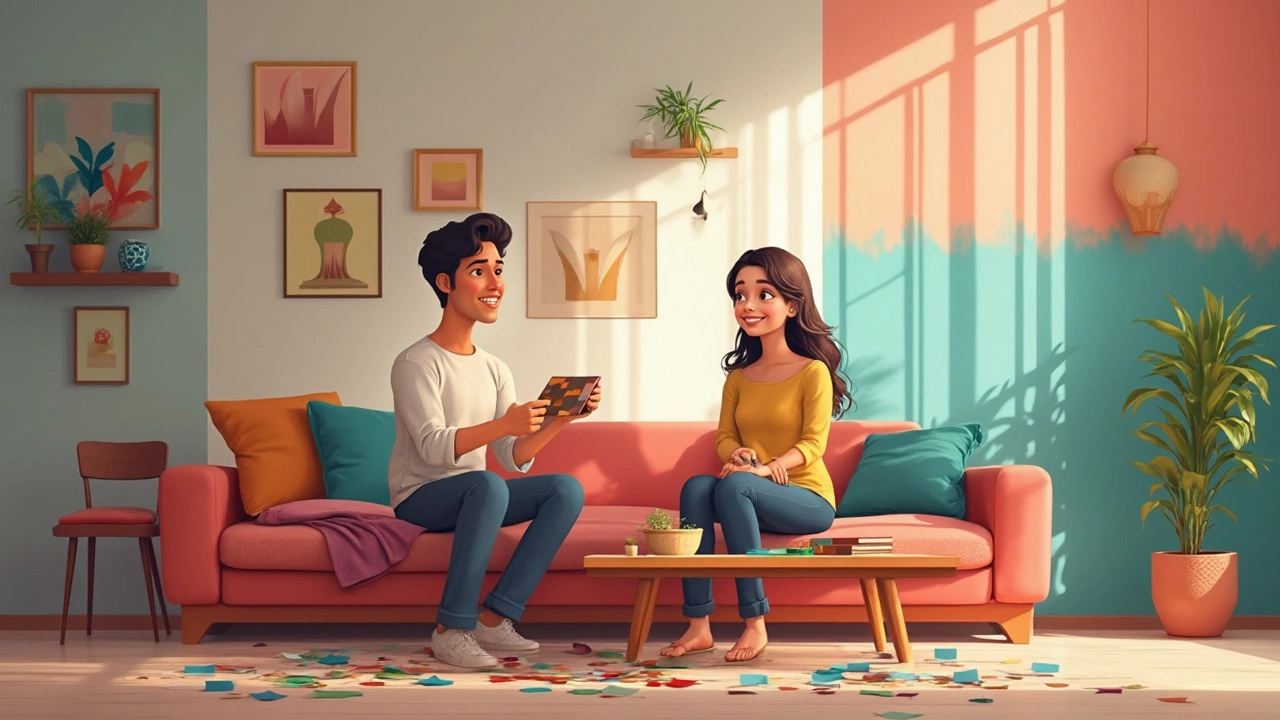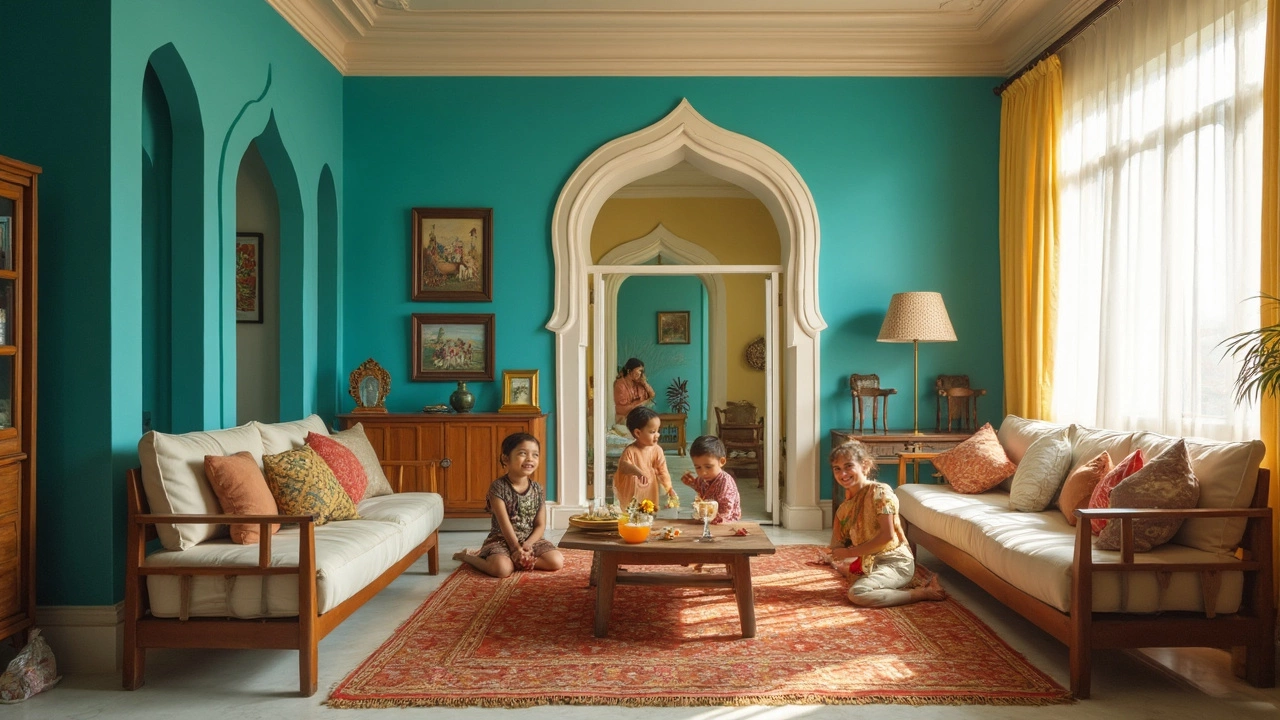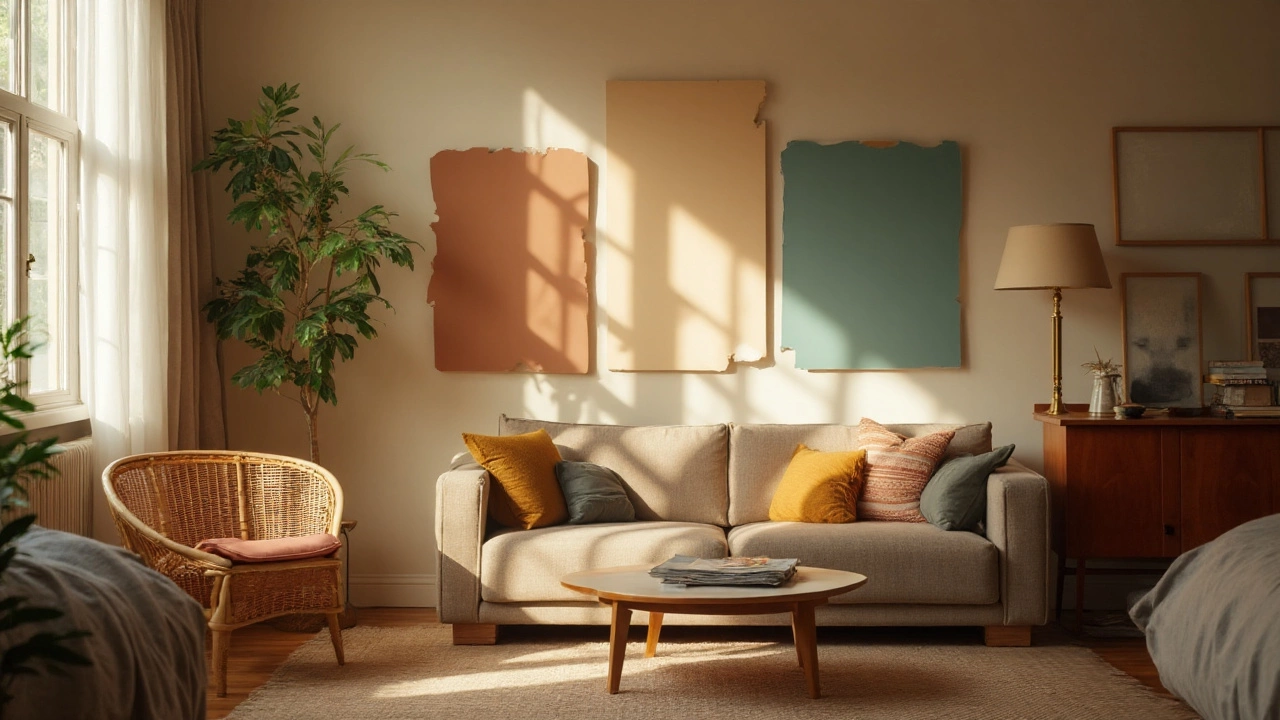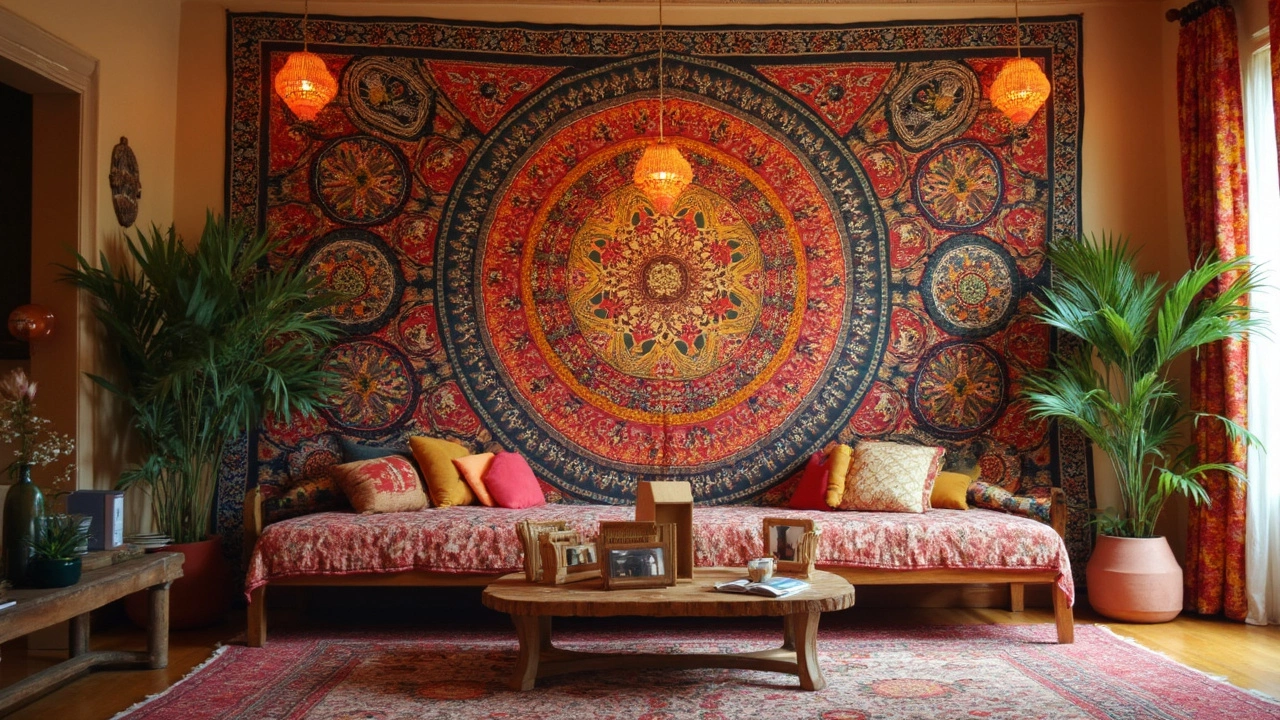Ever walked into a room and felt instantly uplifted—or weirdly uneasy? That's colour doing its thing. The paint you choose for your living room isn’t just about style; it actually shapes your mood. Science backs this up: studies show that certain colours can make people feel happier, calmer, or more energetic. So if your living room doesn’t feel right, a paint update could be a game changer.
It’s not all or nothing, though. Some people swear by sunny yellows or soft greens to create that buzz of positive energy. Others get the same kick from crisp whites or warm earth tones. The trick is picking a shade that looks good with your furniture but also makes you feel good when you plop down after a long day. Small tweaks like painting an accent wall or adding colourful pillows can totally transform the mood, even if you’re on a tight budget.
- Why Colour Matters for Energy
- Top Colours for a Positive Living Room
- How Lighting Changes Everything
- Mixing Shades: What Works (and What Doesn’t)
- Extra Touches: More Than Just Paint
Why Colour Matters for Energy
Colours aren’t just about looks—they pull real strings in your brain. Walk into a blue room and your heart rate drops a little. Step into a space painted orange, and your energy levels can actually go up. That’s not just hype. Research from the University of Manchester found that certain colours change the way your body releases hormones like cortisol (the stress one) and serotonin (the happy one).
It’s not random. Ever notice hospital walls are almost always pale green or blue? That’s because studies consistently show these tones help people relax and recover faster. In the living room, you want more than just chill vibes. You want energy—without feeling edgy. That’s why the best living room colours help boost mood while keeping stress down.
| Colour | Psychological Effect | Best For |
|---|---|---|
| Yellow | Boosts optimism and energy | Common areas, living rooms |
| Green | Balances, calms, refreshes | Family rooms, relaxed spaces |
| Blue | Relaxes, can cool down tempers | Lounges, bedrooms |
| Orange | Stimulates conversation and appetite | Entertainment spaces |
| White | Opens up space, feels pure | Small living rooms |
Don’t underestimate the impact of your wall colour. According to a 2023 survey from a major paint brand, 68% of people said changing their living room colour made them feel noticeably happier at home. So, picking the right shade is less about following trends and more about shaping how you want to live and feel every day.
If your living room makes you feel drained or restless, the colour could be part of the problem. Try observing how you feel at different times of day. If the mood changes, there’s a good chance your paint is either helping or hurting the energy in your space.
Top Colours for a Positive Living Room
Picking the right colour for your living room isn’t just about looks—it actually changes how the whole space feels. According to research from the University of Texas, certain shades can actually make your brain feel more upbeat or more relaxed. When you’re aiming for that positive vibe, some colours work better than others.
- Yellow is like a shot of sunshine for your room. It’s linked to happy feelings and energy. Pale or buttery tones work great if you want something cheerful but not overwhelming. Full-on bright yellow can sometimes be too much, so it’s best for smaller areas or as an accent.
- Green is a winner if you want to bring nature inside. Green reminds people of plants and fresh starts, and it’s known for mid-level energy—bright enough to wake you up, calm enough to keep things relaxed. Sage, mint, and olive are top picks.
- Blue has a proven calming effect and helps your brain chill out. Light blue feels fresh and open, perfect for smaller living rooms that need to feel less cramped. Avoid dark navy if you want to stick to positive, not moody, energy.
- White and off-white are always a safe bet. They bounce more light around, making the room feel bigger and cleaner. Pure white can feel cold, so creamy or warm-whites give a softer look that still feels positive.
- Earth tones like beige, taupe, or soft terracotta add coziness. People feel grounded and secure in spaces with these colours, and it’s easy to mix them with splashes of other brighter shades.
One important tip: no shade works in every place. The exact colour that boosts your energy in a city apartment probably feels different in a countryside home. It makes sense to test out paint samples on your wall, check them through the day, and see which one really makes you feel right. Your own happiness is the best judge, not just what’s trending online or what some design magazine says.
For the best living room colour results, start with a base you love, then layer in a few bright pops with cushions, throws, or artwork. Getting the positive energy you want is usually about getting that balance just right.

How Lighting Changes Everything
If you're after positive energy in your living room, don't just think about paint—the lighting totally changes the game. Even the best living room colour can look dull or jarring with poor lighting. Daylight brings out the real vibe of a paint shade, while artificial lights can change it completely. For example, natural light makes blues feel cooler and whites look crisp, but that same wall might appear yellowish or flat at night under warm bulbs.
Here’s something interesting: a 2021 study from the Journal of Environmental Psychology found that people reported feeling 40% happier in rooms with large windows that brought in daylight. That’s no small boost. Sunlight helps show the true shade of your walls, and it just makes people feel more awake and energized.
| Light Source | How it Changes Colour | Effect on Mood |
|---|---|---|
| Natural Daylight | Keeps colours accurate and vibrant | Lifts positive energy, makes space feel open |
| Warm LEDs/Incandescents | Adds yellowish glow, softens blues and greens | Cozy but can dull bright shades |
| Cool LEDs/Fluorescents | Makes whites and blues pop, may wash out warm tones | Feels lively but can look harsh if overdone |
Want a quick mood shift? Try these easy lighting moves:
- Use dimmers so you can control the brightness based on the time of day.
- Layer different lights—like floor lamps and table lamps—to avoid a flat, boring look.
- If your living room doesn’t get much sunlight, go for bulbs labeled “daylight” (around 5000K) to mimic a fresh vibe.
- Highlight the living room colour you love by aiming spotlights or LEDs at feature walls or artwork.
Mixing good lighting with the right colours literally changes the whole feel of a living room. You don’t have to rewire everything—just swapping out a few bulbs or shifting a lamp can make your decor look completely new and lift the vibe of the space. Even a tiny change makes a difference, especially if you spend lots of time in this room.
Mixing Shades: What Works (and What Doesn’t)
Mixing colours in your living room sounds easy—until you end up with that awkward clash that just feels off. Getting it right is more practical than you think. It’s all about finding combos that spark positive vibes, not chaos. Stick to two or three main shades: more than that, and your room can start to look like a box of mismatched crayons.
The smartest moves? Pair a bold shade with calm neutrals. For example, a punchy yellow accent wall sets off grey or white furniture without making the space overly busy. Light greens or blues team well with earthy browns. If you crave more energy, soft peach or coral pops against white or light beige do the trick. And don’t forget—if you want your living room colour to really shine, add texture. Think chunky throws, patterned rugs, or classic wooden tables.
Here’s where people often go wrong:
- Choosing colours with the same intensity (like bright blue and hot pink)—it overwhelms the eyes and creates stress instead of comfort.
- Mixing lots of dark shades, which can shrink the space and zap any positive energy.
- Picking random colours from different styles (mid-century orange mixed with coastal blue) that fight instead of blend.
Using colour wheels can help. Opposite shades tend to work well (like green and soft pink), while analogous colours—those next to each other, like yellow and green—create smooth, calming transitions. If you’re feeling lost, start with your biggest piece of furniture like the couch, then build your palette around it.
Interesting stat for you: In a 2023 home decor survey, 62% of people said using just two main colours (plus a neutral) made their living rooms feel the most inviting. Check out the breakdown:
| Mixing Strategy | Reported Room Mood | % of Respondents |
|---|---|---|
| Two colours + neutral | Balanced, inviting | 62% |
| Multiple bold colours | Chaotic, busy | 24% |
| Lots of dark shades | Moodier, less positive | 14% |
Quick tip: Paint test swatches on the wall and live with them for a few days. Colours change under different lights and, let's be honest, our moods do too.

Extra Touches: More Than Just Paint
Paint might set the mood, but the stuff you add afterward pulls the whole vibe together in your living room. Think of paint as the base and the extras as the toppings that really make the space yours.
Studies actually show that the textures, lighting, and décor you pick can fuel energy as much as wall colour. Don’t just stop with the roller brush—there’s more you can tweak to boost those good feels.
- Lighting changes everything. Natural light not only makes a room feel bigger and airier, but it also lifts your mood. Swapping heavy curtains for lighter fabrics or pulling blinds all the way up lets sunshine do its thing. If you don’t get much daylight, warm LED bulbs or a few well-placed lamps will stop things feeling flat or gloomy.
- Plants give off serious positive vibes. Even a couple of small potted greens or a snake plant in the corner adds freshness and literally helps clean the air. NASA ran a real test proving plants can remove toxins—so they’re not just a trend, they’re science-backed mood boosters.
- Mirrors bounce light around and widen up small spaces. Stick one across from a window and see how much brighter things feel. It’s an easy trick for more natural light without changing your windows.
- Soft touches count. Chunky knit throws, colourful cushions, and textured rugs add comfort and color. Switching up pillow covers is a budget move that can match your mood with the season—like yellow in spring or cozy earth tones in fall.
- Artwork and personal photos can anchor positive energy. Loads of research shows that seeing memories or visuals you love cranks up feelings of happiness and calm.
The main point here: you don’t have to go wild on renovations. Small, thoughtful changes to furniture, decorations, and lighting can seriously step up the positive energy—even if your walls stay the same colour. It’s all about combining those touches with your favourite living room colour for a result that fits your style and keeps the good vibes coming.



